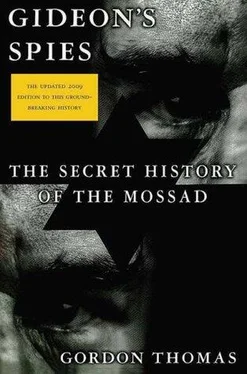Gordon Thomas - Gideon's Spies
Здесь есть возможность читать онлайн «Gordon Thomas - Gideon's Spies» весь текст электронной книги совершенно бесплатно (целиком полную версию без сокращений). В некоторых случаях можно слушать аудио, скачать через торрент в формате fb2 и присутствует краткое содержание. Город: New York, Год выпуска: 2009, ISBN: 2009, Издательство: Thomas Dunne Books, Жанр: История, на английском языке. Описание произведения, (предисловие) а так же отзывы посетителей доступны на портале библиотеки ЛибКат.
- Название:Gideon's Spies
- Автор:
- Издательство:Thomas Dunne Books
- Жанр:
- Год:2009
- Город:New York
- ISBN:978-0-312-53901-6
- Рейтинг книги:4 / 5. Голосов: 1
-
Избранное:Добавить в избранное
- Отзывы:
-
Ваша оценка:
- 80
- 1
- 2
- 3
- 4
- 5
Gideon's Spies: краткое содержание, описание и аннотация
Предлагаем к чтению аннотацию, описание, краткое содержание или предисловие (зависит от того, что написал сам автор книги «Gideon's Spies»). Если вы не нашли необходимую информацию о книге — напишите в комментариях, мы постараемся отыскать её.
Gideon’s Spies
Gideon's Spies — читать онлайн бесплатно полную книгу (весь текст) целиком
Ниже представлен текст книги, разбитый по страницам. Система сохранения места последней прочитанной страницы, позволяет с удобством читать онлайн бесплатно книгу «Gideon's Spies», без необходимости каждый раз заново искать на чём Вы остановились. Поставьте закладку, и сможете в любой момент перейти на страницу, на которой закончили чтение.
Интервал:
Закладка:
Since then the Arab press had been full of dire warnings that Israel would retaliate. Many of the stories had been planted by Mossad’s psychological warfare department to fray still further the nerves of millions of Arabs.
The passengers in the Learjet, who only a few hours before had chanted for the destruction of Israel at the Libyan conference, saw the grim faces of their enemy peering at them. One of the fighters waggled its wings, the follow-me signal recognized the world over by pilots. To reinforce the message, an Israeli pointed a gloved hand straight ahead and then downward toward Galilee. The women on board the jet began to wail; some of the men started to pray. Others stared ahead fatalistically. They all knew this had always been a possibility; the accursed infidels had the capability to reach out and snatch them from the sky.
One of the Israeli aircraft fired a short warning burst from its cannon, warning the Learjet’s captain not to contemplate radioing for help from the Syrian air force—only minutes’ flying time away. The passengers’ fear increased. Were they, too, about to suffer the same fate that had befallen one of the authentic heroes of the Arab world?
Just a month before the Tunis air raid, an Israeli naval patrol boat with Mossad agents on board had stopped a small ship called Opportunity on its regular shuttle between Beirut and Larnaca. From the bilges they had dragged out Faisal Abu Sharah, a terrorist with blood on his hands. He had been bundled on board the patrol boat, the prelude to ruthless interrogation in Israel, followed by a quick trial and a long term in jail. The swiftness and audacity of the operation had yet again enhanced the image of invincibility Israel presented to the Arab world.
Such incidents were not uncommon. Working closely with Israel’s small but highly trained navy, Mossad had since then intercepted several boats and removed passengers suspected of terrorist activities. Not only Israel’s long Mediterranean coast called for vigilance; the Red Sea also presented a constant vulnerability. A Mossad agent in Yemen had been the source for an operation that had thwarted a PLO plot to sail a fishing boat up the Red Sea to the Israeli resort of Elat and detonate its cargo of explosives close to the shore, lined with hotels. An Israeli gunboat had intercepted the fishing boat and overpowered its two suicide bombers before they could detonate the cargo.
As the Learjet descended toward northern Israel, the passengers also feared this was a further retaliation for what had happened when another of their heroes, Abu Al-Abbas, had, only a few months before, on October 2, 1985, taken over the Italian cruise liner Achille Lauro in what was the most spectacular act of maritime piracy the world could recall. Al-Abbas had murdered one of the passengers, Leon Klinghoffer, an American Jew in a wheelchair, by throwing him into the sea.
The crime had become a floating diplomatic incident that had embroiled an outraged Israel and the United States, Egypt, Italy, Syria, Cyprus, Tunisia, and the stateless PLO; for days the crisis had drifted around the Mediterranean, gathering publicity for the hijackers and revealing the self-interest which, in the Middle East, governed attitudes toward terrorism. The hijacking of a cruise liner that was bringing much-needed foreign tourists and hard currency to Israel, followed by the murder of a passenger, provoked a wave of indecision. The murder had technically taken place on Italian soil, the Genova-registered Achille Lauro. But Italy was highly vulnerable to terrorism and wished to see a quiet end to the incident. The United States wanted justice for its murdered citizen. Across the nation appeared stickers proclaiming, “Don’t get mad, get even.” Finally the hijackers, having held the world’s headlines for several days, surrendered to the Egyptian authorities, who then allowed them to leave the country—to the fury of Israel.
More than one of the Learjet’s passengers wondered whether they would now be held in some Israeli jail in an act of revenge. With the fighters still flying almost wingtip to wingtip, the executive jet landed at a military airfield in northern Galilee. A waiting team of Aman interrogators had been told by Mossad that on board were two of the most wanted terrorists in the world, the notorious Abu Nidal and the equally infamous Ahmed Jibril. Instead the interrogators found themselves questioning a bunch of badly frightened Arabs, none of whose names appeared on Israel’s computers. The Learjet was allowed to depart with its passengers.
Israel would insist that the prospect of catching terrorists was the only reason for intercepting the aircraft. But within Mossad was a mood that no opportunity should be lost to create fear and panic in Arab minds. The Aman interrogators had some satisfaction in knowing that the passengers would further the image of an all-powerful Israel.
The head of Aman, Ehud Barak, believed the operation was yet another example of Mossad shooting from the hip, and he made his feeling very clear to Nahum Admoni.
Never a person to suffer a mistake or a rebuke lightly, the Mossad chief set about devising an operation that would not only put an end to the mocking of Mossad on Arab radio stations for being reduced to forcing down an unarmed civilian plane, but one that would also end the sniping within Israel’s own intelligence community that the service he commanded should next time be very sure before it made a fool of them all.
So began an operation which, among much else, would ruin the life of a pregnant Irish chambermaid and send her Arab lover to prison to serve one of the longest sentences given by a British court; cause huge embarrassment to German chancellor Helmut Kohl and French prime minister Jacques Chirac; once more reveal Robert Maxwell in full manipulative fury; cause Syria to be exiled from the world’s diplomatic table; and force all those Arab radio stations that had so gleefully ridiculed Mossad to change their tune.
Like all operations, there were moments of high tensions and periods of patient waiting. It had its quota of human despair, useful anger, and betrayal, but for men like Nahum Admoni, such a plot was the very substance of his life. It went with asking himself the same questions over and over again. Could it work? Would other people actually believe that it had been like that? And, of course, would the real truth remain buried forever?
More certain, Mossad had enlisted the very different skills of two men for the operation. One was a katsa who had served in Britain under the alias of Tov Levy. The other was a Palestinian informer, code-named Abu. The Palestinian had been recruited after being discovered by Mossad stealing from a PLO fund he had been administering in a village on the Israeli-Jordanian border. Playing on his fear that the crime could be revealed through an anonymous tip to the village head, resulting in Abu’s death, Mossad had dragooned him to leave for London. He had been provided with fake documents stating he was a businessman and given living expenses commensurate with his role as a high-flying big spender. His assigned controller was Tov Levy.
In every way Abu fit the classic definition by Uzi Mahnaimi, a former member of the Israeli intelligence community, of what an agent should be: “You spend hours with him, days even; you teach him everything he needs to know, you go through his courses with him, help him, socialize with him, look at his family photographs, you know the names and ages of his children. But the agent is not a human being; you must never think of him as one. The agent is just a weapon, a means to an end, like a Kalashnikov—that is all. If you have to send him to the hanging tree, don’t even think about it. The agent is always a cipher, never a person.”
Читать дальшеИнтервал:
Закладка:
Похожие книги на «Gideon's Spies»
Представляем Вашему вниманию похожие книги на «Gideon's Spies» списком для выбора. Мы отобрали схожую по названию и смыслу литературу в надежде предоставить читателям больше вариантов отыскать новые, интересные, ещё непрочитанные произведения.
Обсуждение, отзывы о книге «Gideon's Spies» и просто собственные мнения читателей. Оставьте ваши комментарии, напишите, что Вы думаете о произведении, его смысле или главных героях. Укажите что конкретно понравилось, а что нет, и почему Вы так считаете.












